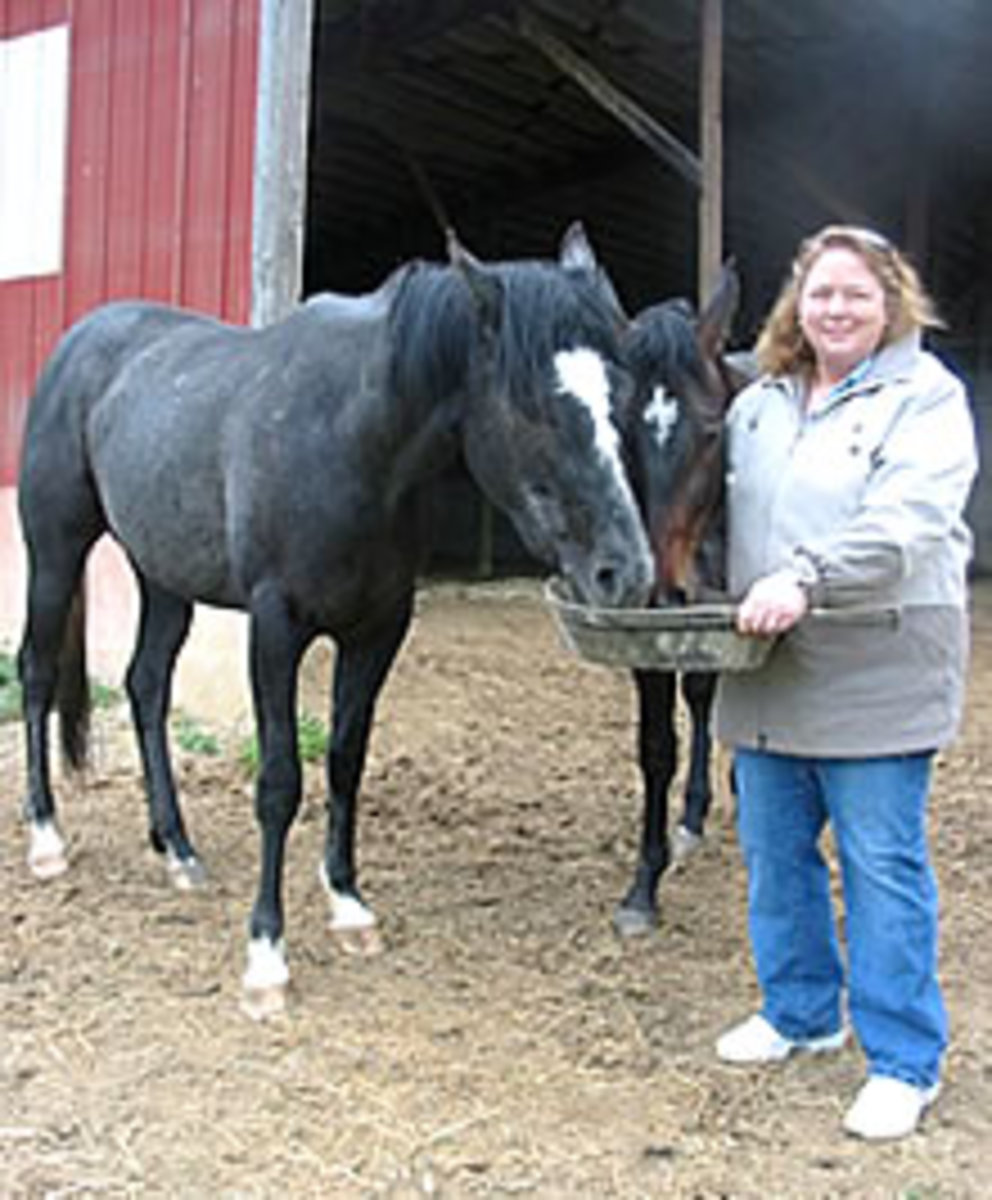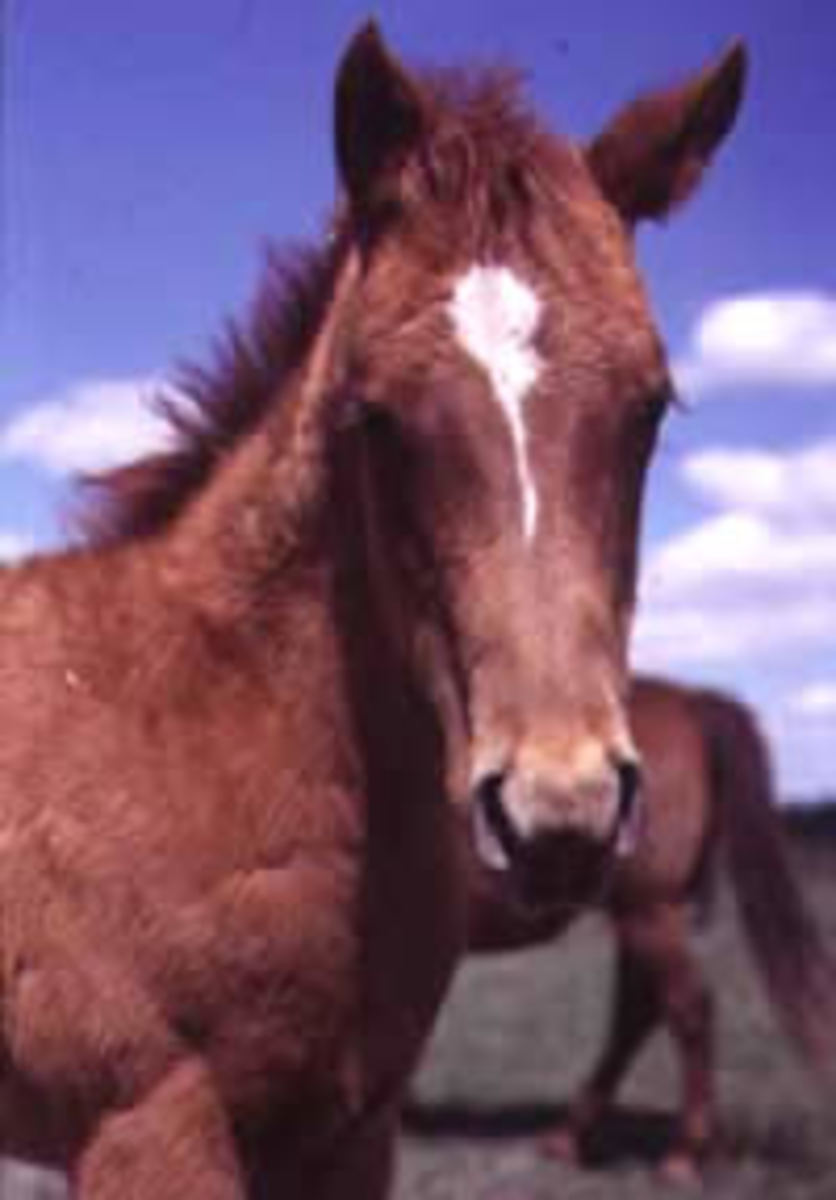My two, 2-year-old mares arrived at dusk on a typically rainy April evening in Maryland. They came off the trailer a bit scruffy but no worse for their 2,000-mile journey from the province of Alberta in Canada. I had done the craziest thing, and here was the proof. I had bought the mares from pictures on the Internet. It was a rescue effort I had learned about from an e-mail forwarded numerous times by a bevy of horse people. I could help save these horses from slaughter and at the same time get a nice young Quarter Horse/Thoroughbred cross.

I went to the website mentioned in the e-mail and saw the faces of about 30 horses looking back at me. They were from a ranch that had lost its contract with the drug company Wyeth-Ayerst Laboratories to produce urine from pregnant mares (PMU). The urine is used in the manufacture of hormones for humans. Premarin? and PREMPRO? are the most popular hormone replacement therapies (HRT) in the United States.
During my research, I discovered the PMU ranches were producing many inexpensive sporthorse types–Thoroughbreds crossed with draft horses and other breeds as well as registered horses such as Paints and American Quarter Horses. This, I thought, is not only a great resource for budget-conscious dressage riders, but also it helps the ranchers and the horses. What a deal. I checked out the people involved and then sent my money.
The story of how the two mares arrived at my door–as part of the thousands of horses produced each year at PMU ranches–is a strange mix of modern science, women’s health needs, independent ranchers, animal activists and passionate horse lovers. And horses connect them all.
PMU Ranching
The story begins 62 years ago in 1942 when chemists discovered that hormones could be extracted from the urine of pregnant mares, processed and given to women in need of hormone replacement. At the time, this was the only HRT available for women with menopausal symptoms and bone loss (osteoporosis). Ranches, mostly in Canada where the program began, were contracted to impregnate mares and collect their urine, which was shipped to a Canadian processing center.
In the beginning, ranchers mostly used low-quality mares. In the spring, the mares are put out to pasture to have their foals. They live in small herds with a stallion and they breed as they would in the wild. In the fall, the mares are moved into barns where, for about six months, they live in standing stalls with some bedding and enough space to lay down. They are fitted with a device that collects their urine around the clock. When spring returns, the cycle begins again.
Barn cleanliness, properly fitting collection devices, nutrition and exercise, not to mention that most of the foals produced went directly to slaughter, were problems that horse people and animal rights activists protested against. During the 1960s and again in the ’70s the PMU ranching industry was investigated, laws were passed and conditions for the horses improved.
In the 1990s inspections by top Canadian and U.S. veterinarians and animal welfare organizations resulted in a handbook setting care guidelines for ranchers to follow. Regular inspections were instituted by Wyeth-Ayerst to see that the guidelines were followed. Conditions for mares continued to improve. Wyeth-Ayerst established Linwood Equine Ranch to study PMU horses and understand their particular health issues, such as how much exercise and nutrition they needed.
In 1995, the North American Equine Ranching Council (NAERIC) was created to assist PMU ranchers in education, breeding and marketing better foals that could be sold as riding horses instead of being sent to slaughter. Director Norman Luba is proud of NAERIC’s programs that reward good breeding and training. They offer scholarships for the children of PMU ranchers and matching funds for NAERIC registered PMU horses that earn prize money at shows. Quarter Horses are the largest breed of registered horses used at PMU ranches.
NAERIC’s CanAm Sporthorse Program is of particular interest to dressage riders because PMU ranchers breed three-quarter Thoroughbred/one-quarter draft crosses. This sporthorse program provides an alternative for dressage, eventing and jumping riders who cannot afford to purchase expensive European warmbloods.
Ranchers are assisted in leasing Thoroughbred stallions to cross with drafts and other breeds. These sporthorses also are eligible for registration in the Performance Horse Registry based with the U.S. Equestrian Federation. Luba says NAERIC sporthorses are filling a niche in the sporthorse market where a nice weanling can be found for about $1,000.
Additional help for PMU mares and foals has come from individuals and organizations formed to assist ranchers in selling foals. FoalQuest’s Jan Turnbull, of Olds, Alberta, began five years ago to talk to ranchers and explain how improving the quality of their breeding program makes their foals a valuable asset.
Turnbull, a wiry, determined woman, states that her organization is not politically motivated. She says is not against the ranchers or the PMU industry, she only wants to find homes for the foals. Along with FoalQuest Vice President Jennifer Kunz and their army of volunteers across North America, Turnbull has sold about 1,300 foals since 1999. Last year, they also placed about 300 mares. There are many organizations doing similar work.
The Winds of Change
PMU contracts are one way for ranchers to make a good living in the Prairie Provinces of Alberta, Saskatchewan and Manitoba, an area depressed by other economic factors. It is a ranching endeavor that is impervious to the weather. Contracts are renewed only yearly, but the industry had shown steady growth over the years.Wyeth-Ayerst, one of the largest drug companies in the world, had been happy with the arrangement, too. The general population of baby boomers was getting older and using more and more Premarin, which had become a billion-dollar-a-year business. At its height about two years ago, the PMU industry contracted with more than 400 independent, mostly family-run ranches with about 36,000 mares involved in PMU production. However, things were about to change.

A study by the National Heart, Lung and Blood Institute was cut short in 2002 when it was discovered that long-term, high doses of hormones were putting women at risk for the very things HRT was supposed to protect them against. Researchers reported in the Journal of the American Medical Association that “a small but unacceptable increase in the rate of breast cancer among the women taking the combination of estrogen (0.625 mg) plus progestin (2.5 mg) daily for longer than 4 years.” The study also showed an increase in heart attack, stroke, and blood clots in the lungs and legs. (For more information on HRT studies, go to the Women’s Health Initiative website www.whi.org and the National Institutes of Health site nhlbi.nih.gov.)
The study received a great deal of publicity, the use of Premarin products declined dramatically and Wyeth-Ayerst decided it was time to cut back PMU production. Ranchers got the word about cuts in October 2003 and again in December: One-third of them would not have their contracts renewed.
After the cutbacks, NAERIC’s Luba says there are now 122 PMU ranches in the Prairie Provinces including four in North Dakota–about 12,000 broodmares. Luba and Wyeth-Ayerst spokesmen say the market is now stable and they don’t expect further reductions.Animal activist groups, such as People for the Ethical Treatment of Animals (www.peta.org) and Stop Wyeth (www.stopwyeth.org) continue to encourage women to choose alternative HRT therapies and boycott Wyeth products. They want PMU ranching to end and for Wyeth-Ayerst to find suitable homes for the horses. They say PMU ranching is inhumane.
In Canada, the cutbacks were bad news for many ranchers–some were from families in their third generation of PMU ranching. For those who planned to retire soon, the Wyeth-Ayerst severance package eased the loss of income and allowed time to sell off horses. For others, who had gone into debt to improve their stock and had plowed profits back into their ranches–for anyone with bank payments to make–the cutbacks came as a terrible shock. Some quickly left home to find work.
Ranchers tell of an auction market so flooded with horses, they received from $50 to $100 for each horse. People buying them were often the “killer buyers” who take horses to feedlots where they are fattened and sent to nearby Bouvry Exports, the largest slaughterhouse in North America. Because of these cutbacks, there will be a particularly large glut of mares and foals that need to be sold by fall 2004. Not every story has a happy ending.
As for my own experience, in true storybook fashion, my young mares escaped the dangers and are munching happily ever after in lush Maryland pastures. My friends and I were lucky with “Charlotte,” a big salt-and-pepper gray, who had been ridden a few times and was already easy to halter and lead–many of these horses have not been handled much and need an experienced horse person.
The other mare was a small mahogany bay I named “Christy.” She swished her tail and backed away when I first touched her. Both were wary of my friends and me, but by the end of a few weeks, after daily handling and feeding, we became their best friends. They are going to be great for dressage and anything else we want to try.
Find a PMU Horse
It is important to check and get references from any group or individual with whom you want to purchase a PMU horse. Make sure to ask about a Coggins test, veterinary and border fees and shipping costs. This is only a small list of groups to contact about buying PMU horses:
- FoalQuest: www.pmufoalquest.com
- Hope for Horses Equine Rescue: www.hopeforhorses.com
- Manitoba Horse Finder: www.pmu.ca
- NEARIC and the CanAm Sporthorse Program: www.naeric.org and www.canamsporthorse.com
- PMU Foal Adoption Network, Inc (FANI): www.pmufoaladoption.org
- Ryerss Farm: www.ryerssfarm.com
- United Pegasus Foundation: www.unitedpegasus.com
- Dave Wolf: www.diamondwquarterhorses.ca
This article originally appeared in the October 2004 issue of Dressage Today magazine.
Ready to look for the right rescue horse for you? Go to Equine.com, the premier classifieds site of the Equine Network, to search for the perfect horse!











